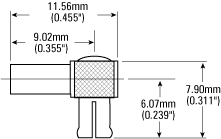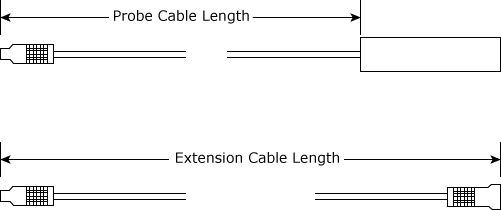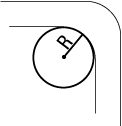Copyright © 2007 Lion Precision. www.lionprecision.com
Summary
Specifications and recommendations for inductive probe cables to maximize performance and durability.
Mechanical
Standard PUR Cable (Black)

High-Temperature FEP Cable (Brown)

Optional Right-Angle Connector

Environmental Considerations
Standard PUR Cables
Standard inductive probes have matte black, PUR (polyurethane) jacketed cables.
Sealing/Reliability
PUR cables provide excellent adhesion with the adhesives used to seal the probe/cable interface. PUR cables are the best choice for applications in environments with high potential for liquid contamination such as coolant sprays or applications requiring immersion of the probe.
Operating Temperature:
-25°C to 125°C
If this temperature is exceeded, the PUR jacket on the cable will soften and be susceptible to damage. At higher temperatures, the jacket will soften sufficiently to flow.
High-Temperature FEP Cables
Inductive probes specified for high temperature have FEP (fluorinated ethylene propylene) jacketed cables. The jacket is semi-transparent brown.
Sealing/Reliability
FEP by its nature only provides limited adhesion for adhesives used to seal the probe/cable interface. These cables are more susceptible to leakage and may have a more limited life expectancy in applications within liquid sprays or applications requiring immersion of the probe.
Operating Temperature:
-55°C to +200°C
Above 200°C the electrical performance of the cable may be compromised and the FEP jacket will begin to soften. Longer term exposures will cause the jacket to melt. Short-term exposures may be tolerated by the cable depending on application and the frequency of exposure. If temperatures beyond these extremes are a factor in an application, contact Lion Precision for a custom solution.
Cable Length/Extensions
Cable length can effect calibration because drivers transmit a high-frequency signal to the probe through the cable. Sensors must be calibrated with the same cables and cable lengths that will be used in operation. If extensions are going to be used, the system should be calibrated with the extensions.
Standard cable length is three meters as measured in the diagram below

An optional two meter extension is available.
Cable Movement During Measurement
Error Noise Generation
Moving the cable can generate noise caused by the “triboelectric” effect. This effect creates small voltage spikes in the cable due to static charges created when the conductors and insulation rub together. This noise is then amplified by the driver electronics and appears in the output signal of the sensor as an error component.
This effect is part of the physics of cabling and is not a function of the driver or probe design. Cable used in Lion Precision probes is specially designed to minimize triboelectric noise.
Generally, this effect is dependent on acceleration. Quick movements of the cable generate more noise than gradual movements of the cable. Impacts on the cable are worst case.
Flexibility (Minimum Bend Radius)

Bend radius is measured on the “inside” of the bend.
The allowable bend radius depends on the application. Select an application below to find the minimum bend radius. Note the measurement of the bend radius on the right. Exceeding the minimum bend radius may result in damage to the cable.
Dynamic Applications (Repeated Bending):
1.6″ (40mm)
Static Applications (Bent occasionally during installation and setup):
0.25″ (6.1mm)
Extreme Applications (Bent only once for extremely tight installations):
0.08″ (2mm)
Cable Protection
Polyethylene
Optional, polyethylene spiral cable wrap is available for additional protection against abrasion. The polyethylene wrap has an operating temperature range of -75°C to 101°C.
Metallic
Flexible metal conduit is also available for maximum cable protection.
